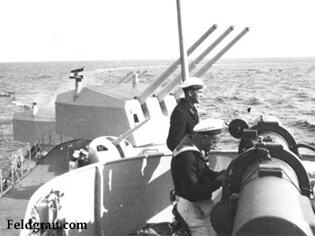The German Navy 1919-1935 (Vorläufige Reichsmarine)

On November 11th, 1918, Germany signed the armistice ending the First World War. On April 16th, 1919, before the Treaty of Versailles was enacted, Germany established a new navy – the Vorläufige Reichsmarine or Interim Imperial German Navy. Two years later on March 31st, 1921, the name was changed when Vorläufige was dropped and the navy became simply the Reichsmarine. It was at this time that the Reichsmarine – which had been founded in 1919 – became the full-fledged German navy. The Reichsmarine flag was first flown on April 11th, 1921, and the Kaiser’s flag was hoisted for the last time on December 31st, 1921. The navy that existed between 1919 and 1935 was in every way transitory, even when the term Vorläufige was removed from the title. The German navy was in every way “Interim” before 1935. The Reichsmarine would exist until May 21st, 1935, when the Kriegsmarine was officially formed.
The first commander of the Vorläufige Reichsmarine was Vice-Admiral Adolf von Trotha. One of Trotha’s first and assuredly most important orders was for the scuttling of the German fleet of nearly 50 ships interned at Scapa Flow on June 21st, 1919, to prevent them from being handed over to the British. The signing of the Treaty of Versailles took place on June 28th, 1919, and the restrictions placed upon the new Vorläufige Reichsmarine was very harsh – more so as a result of the order to scuttle the German fleet a few days earlier.
Although heavily regulated after June of 1919 by the restrictions of the Treaty of Versailles, the Reichsmarine existed none-the-less. The Vorläufige Reichsmarine attempted to carry on the grand traditions of the Kaiserlichemarine of WWI, but it was virtually impotent as a result of a total lack of modern vessels and the lingering scars of the attempted naval mutinies during the last days of WWI. The weak and almost exclusively defensive Reichsmarine existed under the following guidelines, drawn up by the navy itself; To enforce the laws of the state in German coastal areas, to control German territorial waters, to prevent piracy in German waters, to defend German coastal regions from annexation by other coastal states, to control coastal seaplanes, to perform courtesy visits, to secure against naval blockades, and to perform the various hydrographic survey, fishery protection, and oceanographic work. Naval planners wouldn’t have to wait long for the beginnings of a stronger navy though, as preparations for an increasingly powerful navy began to take place almost as soon as the Treaty restricting such things was signed. The Kriegsmarine – formed in 1935 – had its roots founded firmly in the advances of the Reichsmarine. In fact, most of the vintage WWI Reichsmarine ships would go on to become an actual part of the new Kriegsmarine, and many of the major ships of the Kriegsmarine were launched during the Reichsmarine period.
Listed below are those ships that are known to have served in the Reichsmarine. The first listing is of the ships that survived WWI and served in the initial Vorläufige Reichsmarine, the second listing is of those ships launched during the period of the Reichsmarine between 1919-1935. In both cases, those ships that are known to have gone on to serve in the Kriegsmarine are marked as such.
Ships that Survived WWI and Served in the Vorläufige Reichsmarine:
Battleships:
- Braunschweig
- Elass
- Hessen
- Preussen
- Lothringen
- Hannover
- Schlesien*
- Schleswig-Holstein*
Cruisers:
- Niobe*
- Nymphe*
- Thetis*
- Amazone
- Medusa
- Arkona
- Hamburg
- Berlin
Destroyers:
- V1
- V2
- V3
- V5
- V6
- G6
- G7 (later T108)
- G8 (later T109)
- G10 (later T110)
- G11 (later T111)
- S18
- S19
- S23
Torpedo Boats:
- T108* (ex-G7)
- T109* (ex-G8)
- T110* (ex-G10)
- T111* (ex-G11)
- T151*
- T152*
- T153*
- T154*
- T155*
- T156*
- T157*
- T158*
- T175
- T185
- T190*
- T196
Minesweepers
- 38 Vessels
Gunnery Tenders
- Drache
- Hay
- plus 5 others
Auxiliary Vessels
- 18 Picket vessels
- 8 fishery protection vessels
- 2 accommodation ships
- 4 survey vessels
- 1 sailing ship
- various minor craft
Ships Built for the Vorläufige Reichsmarine Between 1919 – 1935:
Armored Ships:
- Deutschland* (initially ersatz Preussen)
- Admiral Scheer* (initially ersatz Lothringen)
- Admiral Graf Spee* (initially ersatz Braunschweig)
Cruisers:
Torpedo Boats:
- Möwe*
- Seeadler*
- Greif*
- Albatros*
- Kondor*
- Falke*
- Wolf*
- Iltis*
- Luchs*
- Tiger*
- Jaguar*
- Leopard*
Submarines:
- U1*
- U2*
- U2*
- U3*
- U4*
- U5*
- U25*
- U26*
Fast Attack Craft:
- Narwal UZ(S)18
- K-boat UZ(S)12
- UZ(S)16 (later W.1, W = Guard Boat)
- S2*
- S3*
- S4*
- S5*
- S6*
- S7*
- S8*
Other Vessels:
- Elbe* (fishery protection vessel)
- Weser* (fishery protection vessel)
- Bremse* (gunnery training ship)
- R1* (motor minesweeper)
- R2* (“)
- R3* (“)
- R4* (“)
- R5* (“)
- R6* (“)
- R7* (“)
- R8* (“)
- R9* (“)
- R10* (“)
- R11* (“)
- R12* (“)
- R13* (“)
- R14* (“)
- R15* (“)
- R16* (“)
RESEARCH THEMES
OUR RESEARCH THEMES
Select ThemeReichswehrThe German Imperial Army 1918 – 1935
anchourReichsmarineThe German Navy 1919-1935
anchourHeerThe Nazi German Army 1935-1945
anchourLuftwaffeThe Nazi German Air Force 1935-1945
anchourKriegsmarineThe Nazi German Navy 1935-1945
anchourWaffen-SSThe Nazi German Armed Waffen-SS 1933-1945
anchourWehrmachtsgefolgeAuxiliary Organizations
anchourFreiwilligeForeign Volunteers
anchourAlliierteAxis Powers
anchourKollaborationAxis Collaboration
anchour
